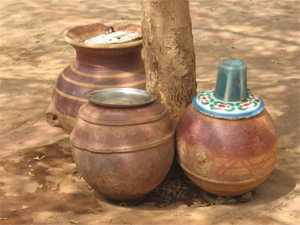Safe Water Storage

Safe water storage vessels
Safe Water Storage [PDF – 2 pages]
Safe water storage means that once the water has been treated and is safe to use, it is stored in a container that protects the water from re-contamination.
Elements of a Safe Water Storage Container
It is preferable to store treated water in plastic, ceramic, or metal containers with the following characteristics, which serve as physical barriers to recontamination:
- A small opening with a lid or cover that discourages users from placing potentially contaminated items, such as hands, cups, or ladles, into the stored water;
- A spigot or small opening to allow easy and safe access to the water without requiring the insertion of hands or objects into the container; and,
- A size appropriate for the household water treatment method, with permanently attached instructions for using the treatment method and for cleaning the container.
If containers with these characteristics are not available, efforts should be made to educate household water treatment users to access the water by pouring from the containers rather than dipping into it with a possibly contaminated object. Safe storage containers are also effective at preventing contamination of water before treatment during transport and storage, but will not eliminate contaminants that were present before the water was put in the container.
Safe Storage Options
Safe storage options fall into three general categories: 1) existing water storage containers in the home; 2) water storage containers used in the community and modified by an intervention program; or, 3) commercial safe storage containers purchased by the program and distributed to users.
To determine the appropriate safe storage container for a program, first identify containers currently used for water collection, transport, and storage in the community, as these existing containers might already be safe, or could easily be modified to be safe storage containers. Programs are also encouraged to review the options for modified and commercially produced safe water storage containers, such as the Oxfam Bucket, the CDC SWS Container, Jerry Cans, a Bucket with Lid and Tap, and Modified Clay Pots, to determine which one may be most appropriate.
Care should be taken to avoid using any container previously used for transport of toxic materials (such as pesticides or petroleum products) as a drinking water storage container. Lastly, locally appropriate cleaning mechanisms – such as use of soap and brushes, or dilute chlorine solution – should be developed and recommended to clean the container on a regular basis.
For more information on safe water storage containers, contact healthywater@cdc.gov.
- Page last reviewed: March 21, 2012
- Page last updated: July 17, 2014
- Content Source:


 ShareCompartir
ShareCompartir